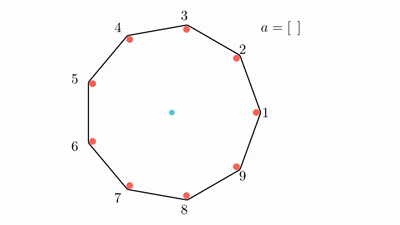CF1764D.Doremy's Pegging Game
普及/提高-
通过率:0%
AC君温馨提醒
该题目为【codeforces】题库的题目,您提交的代码将被提交至codeforces进行远程评测,并由ACGO抓取测评结果后进行展示。由于远程测评的测评机由其他平台提供,我们无法保证该服务的稳定性,若提交后无反应,请等待一段时间后再进行重试。
题目描述
Doremy has n+1 pegs. There are n red pegs arranged as vertices of a regular n -sided polygon, numbered from 1 to n in anti-clockwise order. There is also a blue peg of slightly smaller diameter in the middle of the polygon. A rubber band is stretched around the red pegs.
Doremy is very bored today and has decided to play a game. Initially, she has an empty array a . While the rubber band does not touch the blue peg, she will:
- choose i ( 1≤i≤n ) such that the red peg i has not been removed;
- remove the red peg i ;
- append i to the back of a .
Doremy wonders how many possible different arrays a can be produced by the following process. Since the answer can be big, you are only required to output it modulo p . p is guaranteed to be a prime number.
 game with n=9 and a=[7,5,2,8,3,9,4] and another game with n=8 and a=[3,4,7,1,8,5,2]
game with n=9 and a=[7,5,2,8,3,9,4] and another game with n=8 and a=[3,4,7,1,8,5,2]
输入格式
The first line contains two integers n and p ( 3≤n≤5000 , 108≤p≤109 ) — the number of red pegs and the modulo respectively.
p is guaranteed to be a prime number.
输出格式
Output a single integer, the number of different arrays a that can be produced by the process described above modulo p .
输入输出样例
输入#1
4 100000007
输出#1
16
输入#2
1145 141919831
输出#2
105242108
说明/提示
In the first test case, n=4 , some possible arrays a that can be produced are [4,2,3] and [1,4] . However, it is not possible for a to be [1] or [1,4,3] .